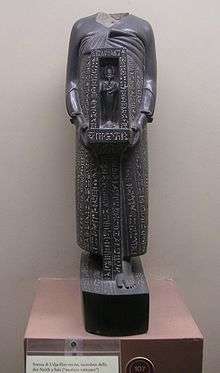Udjahorresnet
Udjaḥorresnet (or Wedjaḥorresnet, and many other variants) was an ancient Egyptian high official who lived between the end of the 26th Dynasty and the beginning of the 27th Dynasty. He is mainly known for his efforts in promoting the Egyptian customs to the early Achaemenid kings of the 27th Dynasty.
| Udjaḥorresnet | |
|---|---|
 Naophoros statue of Udjahorresnet. Rome, Museo Gregoriano Egizio | |
| Dynasty | 26th-27th Dynasty |
| Pharaoh | Amasis II, Psamtik III, Cambyses II, Darius I |
| Burial | shaft tomb at Abusir? |
We know about his remarkable and controversial career thanks to his autobiography, inscribed on a well known statue depicting him; the statue, commonly called Naoforo vaticano (Italian for "Vatican naos-carrier") was originally placed in the temple of Neith at Sais likely in Year 3 of Darius I (c. 519 BCE) and is now exhibited inside the Vatican Museums (more precisely in the Museo Gregoriano Egizio) of Rome.[1]:166
Biography
| Udjaḥorresnet in hieroglyphs |
|---|
Early in his career, during the reigns of pharaohs Amasis II and Psamtik III, Udjahorresnet was a commander of ships (admiral), a physician and a priest of Neith in Sais.[2] After the defeat at Pelusium in 525 BCE and the subsequent conquest of Egypt by Cambyses II, he eventually was relieved from his military duties.[1]:168-9
Nevertheless, his influence grew unexpectedly under the reign of the foreign kings, Cambyses and his successor Darius I: Udjahorresnet apparently became a sort of collaborationist for the Persians, managing to enter in the royal court as chancellor and chief physician. From his statue, it is known that he used his influence to make Cambyses acknowledge and respect Egyptian customs.[2] Acculturated by Udjahorresnet, the pharaoh paid homage to the goddess Neith at Sais, not before having driven out many Persian squatters who had settled within the temple; Udjahorresnet himself composed Cambyses' pharaonic titulary, calling him the Horus Smatawy (”He who unifies the Two Lands”) and the King of Upper and Lower Egypt Mesutire (“Offspring of Ra”).[1]:169
After Cambyses' death (522 BCE), Udjahorresnet's mission continued with Darius I: in fact, he even escorted Darius on his return to Susa[2] and before returning to Egypt, he persuaded the new pharaoh to entrust to him the restoration of Per-ankh (the “House of Life”), a well known educational and cultural institution in ancient Egypt.[1]:173[3]
Udjahorresnet probably died later during Darius' reign. His huge shaft tomb at Abusir was excavated between 1980 and 1993, and found looted in antiquity.[4]:7 It is still a matter of debate if Udjahorresnet was indeed buried here or not;[4]:79 if not, it is possible that he died and was entombed in Persia rather than Egypt.[5]
References
- Lloyd, Alan B. (1982). "The inscription of Udjahorresnet. A collaborator's testament". Journal of Egyptian Archaeology. 68: 166–190.
- Rice, Michael (2004). Who is who in Ancient Egypt. London: Routledge. ISBN 0-203-44328-4. p. 212.
- Bunson, Margaret (2009). Encyclopedia of Ancient Egypt. Infobase Publishing. ISBN 1438109970. p. 419.
- Bares, Ladislav (1999). Abusir: Excavations of the Czech Institute of Egyptology, vol. IV: The shaft tomb of Udjahorresnet at Abusir. Prague: Universitas Carolina Pragensis.
- Bresciani, Edda (2001). Nove faraoni [Nine pharaohs] (in Italian). Pisa: Edizioni Plus, Università di Pisa. ISBN 88-8492-095-7. p. 105
Further reading
- Lopez, Francesco (2015). Democede di Crotone e Udjahorresnet di Sais. Medici primari alla corte achemenide di Dario il Grande [Democedes of Croton and Udjahorresnet of Sais. Chief physicians at the Achaemenid court of Darius the Great] (in Italian). Pisa: Pisa University Press.